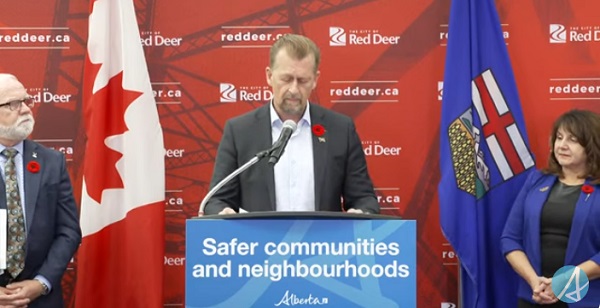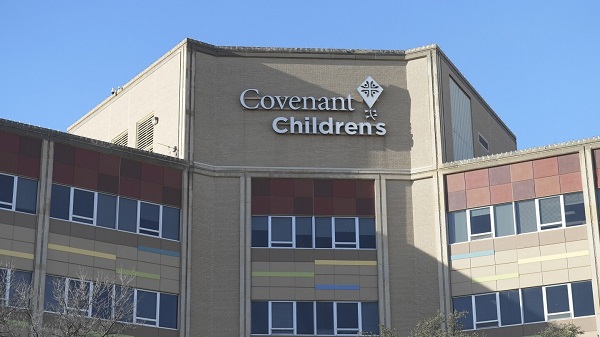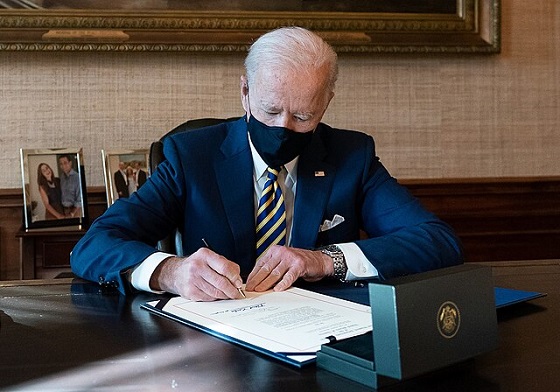Alberta
New Sheriffs unit to enhance public safety in Red Deer and Central Alberta

A new team of Alberta Sheriffs will work alongside police to keep crime out of central Alberta communities by targeting problem properties.
Since 2023, Alberta’s government has invested more than $27 million to help fight crime throughout the province. Building on these efforts, the government is now expanding the Alberta Sheriffs’ Safer Communities and Neighbourhoods (SCAN) unit with the creation of a new team of investigators in Red Deer. The creation of the Red Deer SCAN team is the latest in a series of measures aimed at enhancing public safety and increasing the Alberta Sheriffs’ ability to support police throughout the province.
The move puts more resources on the ground with a team of qualified experts who will investigate properties where illegal activity has been reported and shut them down through court orders when needed. The Red Deer SCAN team – made up of four Alberta Sheriffs – joins existing SCAN teams in Calgary, Edmonton, and Lethbridge, which have proven immensely effective in working alongside local police to shutter problem properties throughout the province.
“Alberta’s government will always maintain a zero-tolerance stance toward crime of any kind, and the expansion of the Alberta Sheriffs’ SCAN unit reflects that. With the creation of a new SCAN team in Red Deer, we’re expanding the unit’s coverage even further and putting more boots on the ground where they’re needed. Let this be a message to all criminals: you are not welcome here. Communities in the Red Deer area have a right not to be plagued by drug and other criminal activity that create dangerous environments, and Alberta’s government will do whatever it takes to keep people safe.”
The Sheriffs’ SCAN unit operates under the Safer Communities and Neighbourhoods Act, which uses legal sanctions and court orders to hold owners accountable for illegal activity happening on their property, such as drug trafficking, human trafficking and child exploitation. SCAN augments and supports local police to both investigate and close properties where evidence of criminal activity has been confirmed.
“Ensuring safety for law-abiding Albertans is of utmost importance for Alberta’s government and requires a comprehensive approach to effectively combat and prevent criminal activity. This involves enhancing law-enforcement resources, fostering community engagement, implementing crime prevention programs, and promoting collaboration between Alberta Sheriffs and local police. This SCAN team is a game-changer in central Alberta and puts criminals on notice that they are not welcome here.”
“The Safer Communities and Neighbourhoods Act holds property owners accountable for activities on their property that threaten public safety. Alberta’s SCAN teams support policing efforts by addressing illegal activities on these properties. This additional team will enhance RCMP community safety programs.”
When a community member reports a problem property to SCAN, the unit begins an investigation. Once the investigation confirms the activity, investigators contact the property owner to try and resolve the issue informally. If informal efforts are unsuccessful, SCAN can apply to the courts for a community safety order to impose restrictions and conditions on the property and its owner, which could include closing the property for up to 90 days. Any criminal activity uncovered when dealing with these properties is turned over to the police to investigate.
“Over the years, SCAN’s impact on community safety has been profound. More often than not, we see individuals in these problem properties carrying out drug operations and other criminal activities beside homes, schools, playgrounds and other places where Albertans’ safety should never be in question. Crime has no place in any Alberta neighbourhood, and we look forward to working with our policing partners in the Red Deer area to help keep central Alberta communities safe.”
SCAN continues to see tremendous success, having closed problem properties in Lethbridge, Calgary, Spruce Grove and Medicine Hat in the last six months alone. Since May 2024, Alberta’s government has publicly announced the closure of seven problem properties by SCAN, including three in Calgary, two in Lethbridge, and one each in Spruce Grove and Medicine Hat.
“Creating a safer environment for our citizens improves the overall quality of our community in Red Deer. I would like to take this opportunity to thank Alberta’s government, SCAN and all our law enforcement partners who work tirelessly every day to keep our communities safe. This is great news for the City of Red Deer, and together, we can make our community safer. I encourage residents to report any suspicious activity to the SCAN unit.”
The Red Deer SCAN team’s operational boundaries encompass the city of Red Deer and its surrounding communities and rural areas, providing coverage to the central area spanning Ponoka to the north and Olds to the south.
Alberta
Made in Alberta! Province makes it easier to support local products with Buy Local program

Show your Alberta side. Buy Local. |
When the going gets tough, Albertans stick together. That’s why Alberta’s government is launching a new campaign to benefit hard-working Albertans.
Global uncertainty is threatening the livelihoods of hard-working Alberta farmers, ranchers, processors and their families. The ‘Buy Local’ campaign, recently launched by Alberta’s government, encourages consumers to eat, drink and buy local to show our unified support for the province’s agriculture and food industry.
The government’s ‘Buy Local’ campaign encourages consumers to buy products from Alberta’s hard-working farmers, ranchers and food processors that produce safe, nutritious food for Albertans, Canadians and the world.
“It’s time to let these hard-working Albertans know we have their back. Now, more than ever, we need to shop local and buy made-in-Alberta products. The next time you are grocery shopping or go out for dinner or a drink with your friends or family, support local to demonstrate your Alberta pride. We are pleased tariffs don’t impact the ag industry right now and will keep advocating for our ag industry.”
Alberta’s government supports consumer choice. We are providing tools to help folks easily identify Alberta- and Canadian-made foods and products. Choosing local products keeps Albertans’ hard-earned dollars in our province. Whether it is farm-fresh vegetables, potatoes, honey, craft beer, frozen food or our world-renowned beef, Alberta has an abundance of fresh foods produced right on our doorstep.
Quick facts
- This summer, Albertans can support local at more than 150 farmers’ markets across the province and meet the folks who make, bake and grow our food.
- In March 2023, the Alberta government launched the ‘Made in Alberta’ voluntary food and beverage labelling program to support local agriculture and food sectors.
- Through direct connections with processors, the program has created the momentum to continue expanding consumer awareness about the ‘Made in Alberta’ label to help shoppers quickly identify foods and beverages produced in our province.
- Made in Alberta product catalogue website
Related information
Alberta
Province to expand services provided by Alberta Sheriffs: New policing option for municipalities

Expanding municipal police service options |
Proposed amendments would help ensure Alberta’s evolving public safety needs are met while also giving municipalities more options for local policing.
As first announced with the introduction of the Public Safety Statutes Amendment Act, 2024, Alberta’s government is considering creating a new independent agency police service to assume the police-like duties currently performed by Alberta Sheriffs. If passed, Bill 49 would lay additional groundwork for the new police service.
Proposed amendments to the Police Act recognize the unique challenges faced by different communities and seek to empower local governments to adopt strategies that effectively respond to their specific safety concerns, enhancing overall public safety across the province.
If passed, Bill 49 would specify that the new agency would be a Crown corporation with an independent board of directors to oversee its day-to-day operations. The new agency would be operationally independent from the government, consistent with all police services in Alberta. Unlike the Alberta Sheriffs, officers in the new police service would be directly employed by the police service rather than by the government.
“With this bill, we are taking the necessary steps to address the unique public safety concerns in communities across Alberta. As we work towards creating an independent agency police service, we are providing an essential component of Alberta’s police framework for years to come. Our aim is for the new agency is to ensure that Albertans are safe in their communities and receive the best possible service when they need it most.”
Additional amendments would allow municipalities to select the new agency as their local police service once it becomes fully operational and the necessary standards, capacity and frameworks are in place. Alberta’s government is committed to ensuring the new agency works collaboratively with all police services to meet the province’s evolving public safety needs and improve law enforcement response times, particularly in rural communities. While the RCMP would remain the official provincial police service, municipalities would have a new option for their local policing needs.
Once established, the agency would strengthen Alberta’s existing policing model and complement the province’s current police services, which include the RCMP, Indigenous police services and municipal police. It would help fill gaps and ensure law enforcement resources are deployed efficiently across the province.
Related information
-

 2025 Federal Election2 days ago
2025 Federal Election2 days agoCommunist China helped boost Mark Carney’s image on social media, election watchdog reports
-

 2025 Federal Election2 days ago
2025 Federal Election2 days agoConservative Party urges investigation into Carney plan to spend $1 billion on heat pumps
-

 2025 Federal Election2 days ago
2025 Federal Election2 days agoFifty Shades of Mark Carney
-

 Health2 days ago
Health2 days agoExpert Medical Record Reviews Of The Two Girls In Texas Who Purportedly Died of Measles
-

 2025 Federal Election1 day ago
2025 Federal Election1 day agoCorporate Media Isn’t Reporting on Foreign Interference—It’s Covering for It
-

 COVID-192 days ago
COVID-192 days agoBiden Admin concealed report on earliest COVID cases from 2019
-

 2025 Federal Election2 days ago
2025 Federal Election2 days agoMark Carney To Ban Free Speech if Elected
-

 MAiD2 days ago
MAiD2 days agoDisability rights panel calls out Canada, US states pushing euthanasia on sick patients





